
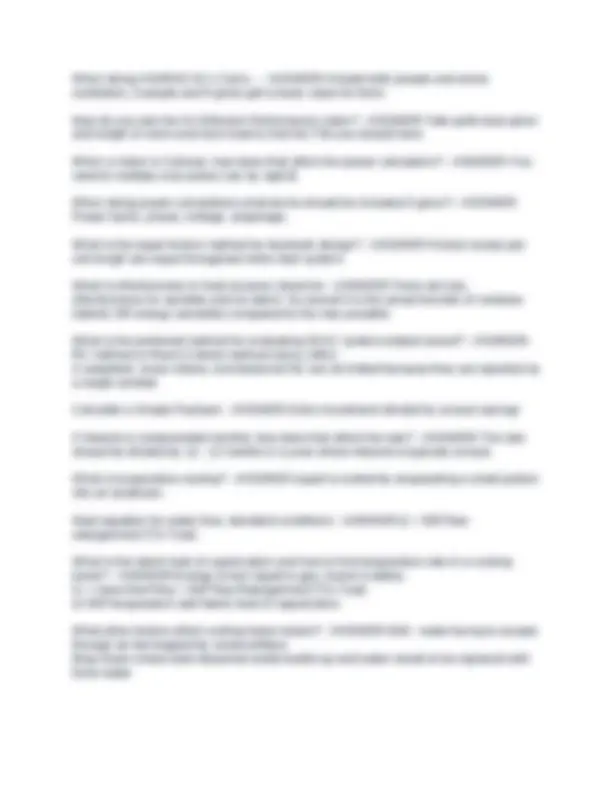
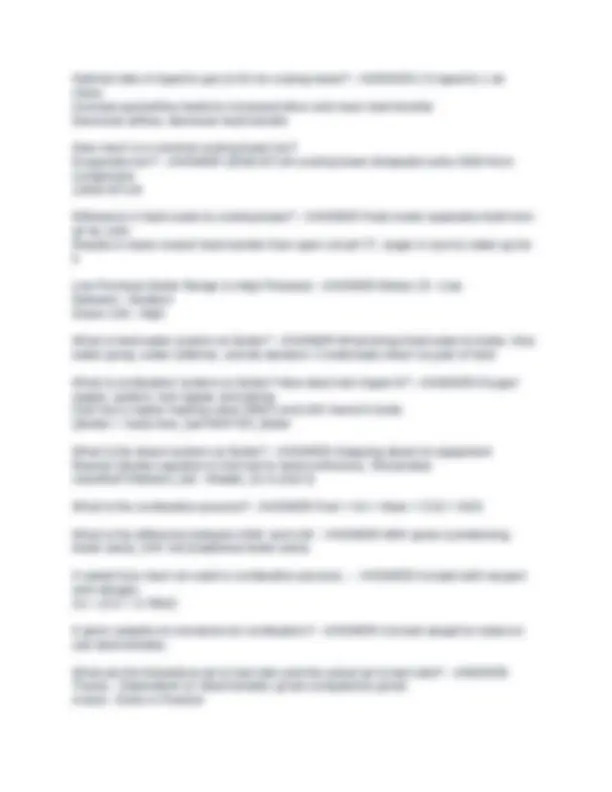
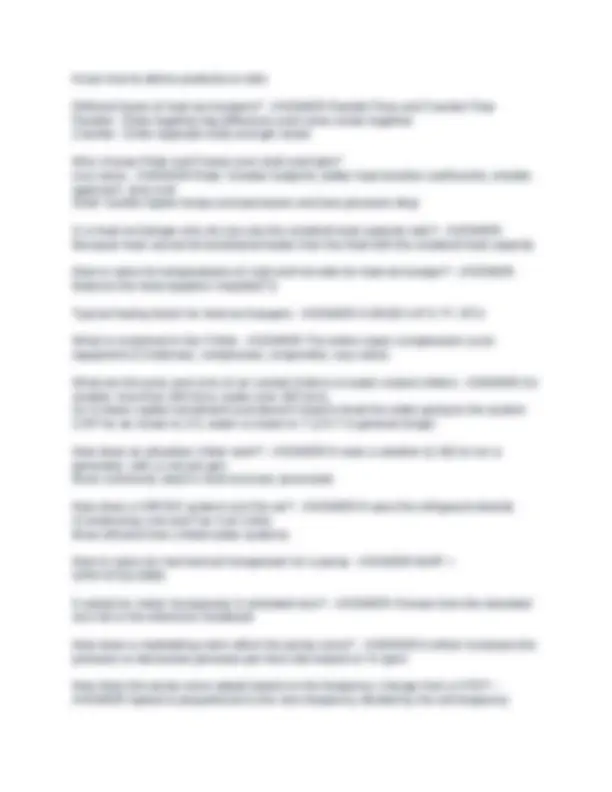
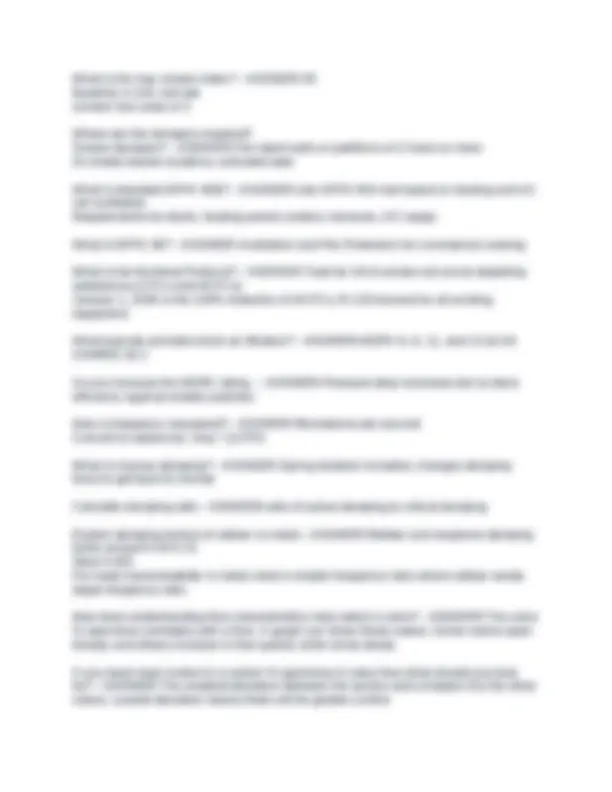
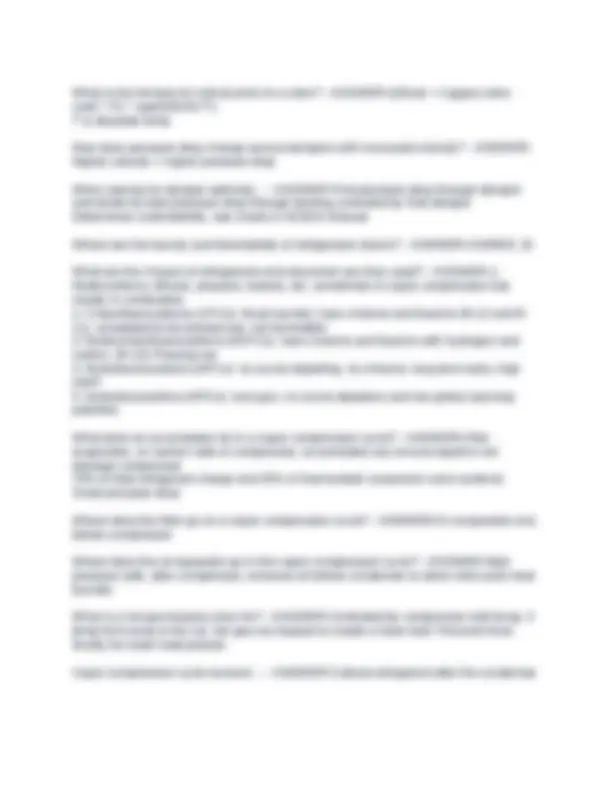
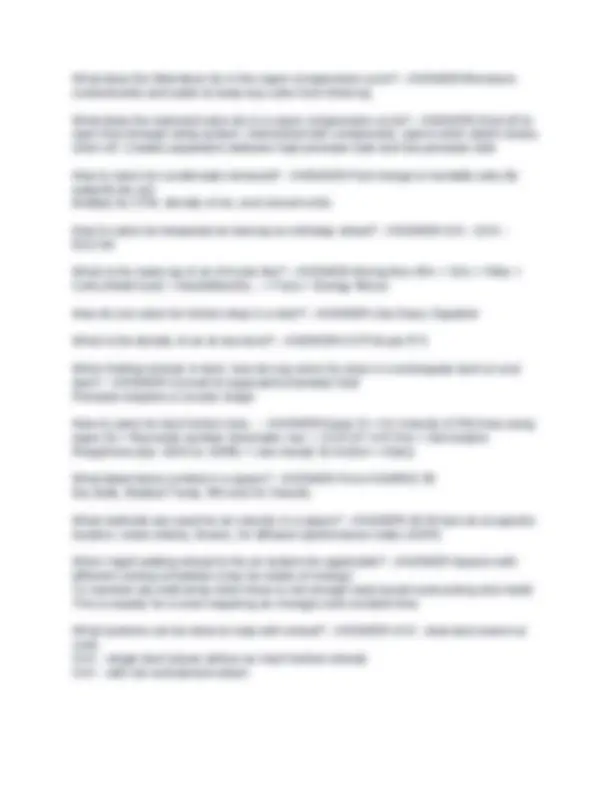
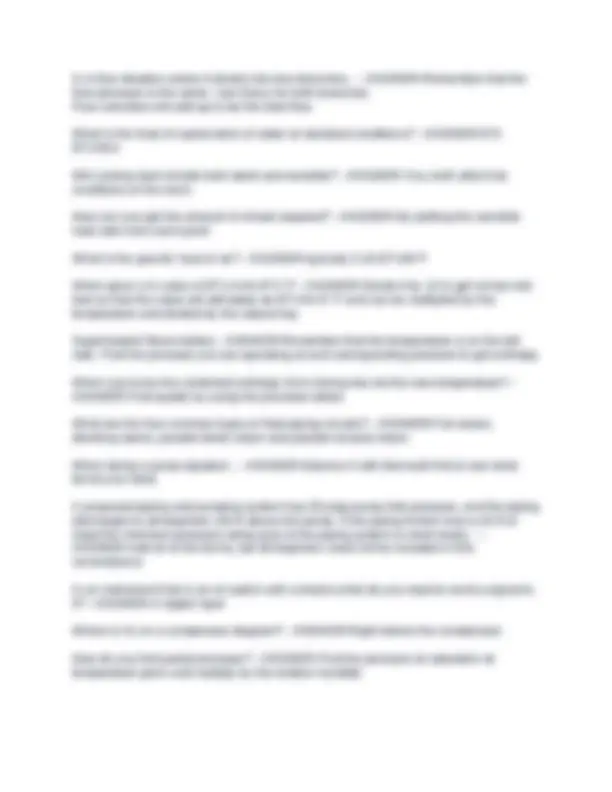
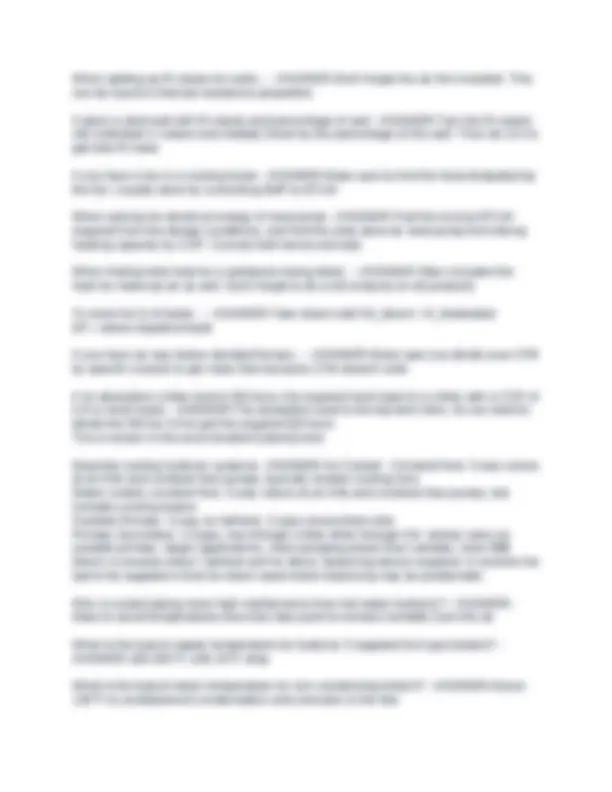
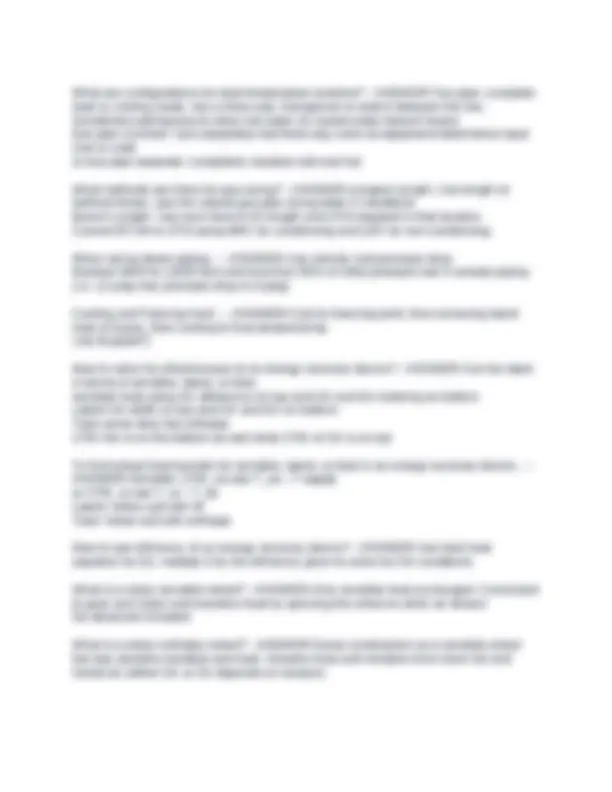
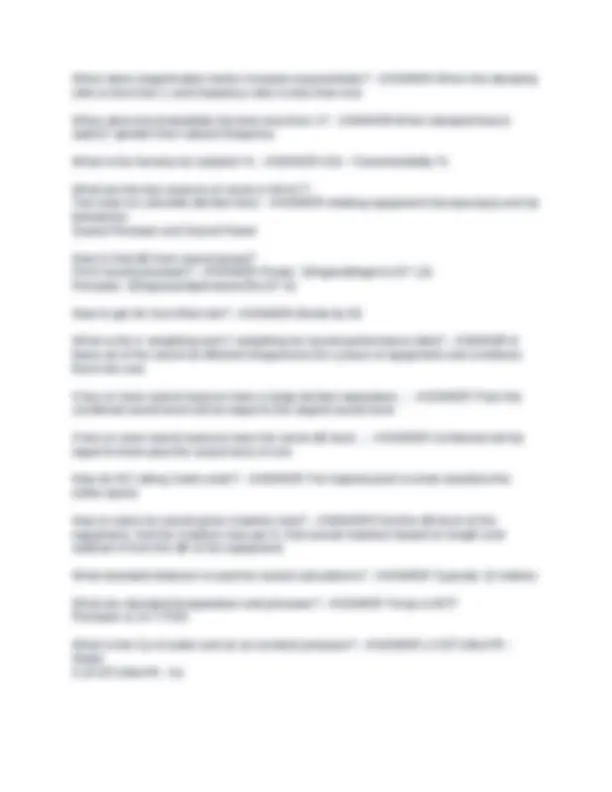
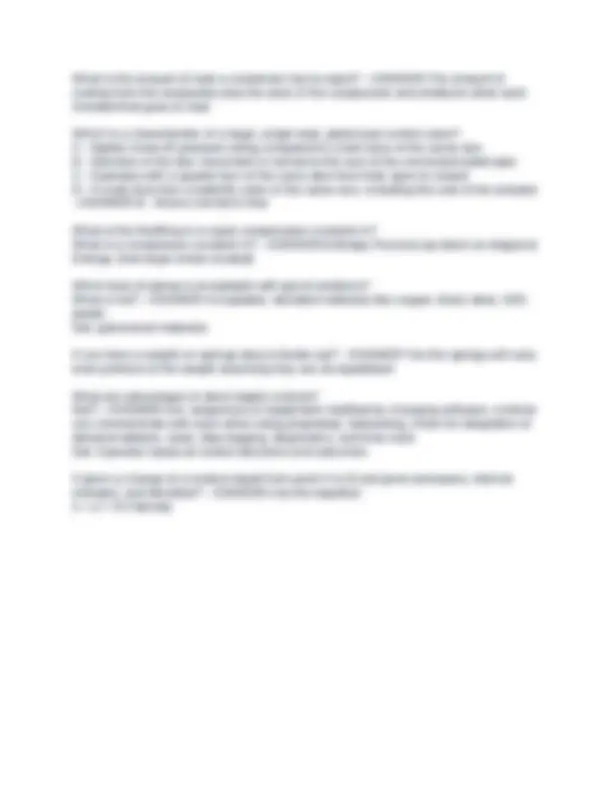


Study with the several resources on Docsity

Earn points by helping other students or get them with a premium plan


Prepare for your exams
Study with the several resources on Docsity

Earn points to download
Earn points by helping other students or get them with a premium plan
Community
Ask the community for help and clear up your study doubts
Discover the best universities in your country according to Docsity users
Free resources
Download our free guides on studying techniques, anxiety management strategies, and thesis advice from Docsity tutors
PE Exam Study Guide with Accurate Solutions
Typology: Exams
1 / 19

This page cannot be seen from the preview
Don't miss anything!












Cooling Tower Effectiveness Calculation - ANSWER-Range / Range + Approach Cooling Tower Range - ANSWER-Twater-in - Twater-out Cooling Tower Approach - ANSWER-Twater-out - Tair-wb-in Describes level of performance of cooling tower. Smaller approach > more heat transfer
better at cooling (typically ~10°F) Greatest limiting factor of thermal performance for evaporative cooling tower - ANSWER-WB Temp Solve for Coil Efficiency - ANSWER-EFF = 1 - Bypass Factor How to solve for the Bypass Factor - ANSWER-(Tdb,out - Tcoil)/(Tdb,in - Tcoil) What is the apparatus dew point for a coil - ANSWER-The overall coil temperature How is infinite variation over controller range accomplished? - ANSWER-With modulating control (or proportional, proportional-integration ie PI, or PID ie proportional- integral-derivative action) Refrigeration condensers are rated based on ability to reject total heat from... - ANSWER-compressor work and net refrigeration effect Equation for Qlat at standard - ANSWER-Q = 4840CFMdel(Wlb) Types of Chillers and Ranges - ANSWER-Reciprocating 10- Scroll 10- Rotary Screw 70- Centrifugal 125-10, Convert from psig to psia - ANSWER-psig + 14.7 = psia (14.7 is atmospheric) What is the SG of water? - ANSWER-Look on definitions, it is the density of the fluid divided by density of water. So for water it is 1.
What does a reversing valve do? - ANSWER-It is typically a four way valve between condenser (indoor) and evaporator (outdoor) modes. It switches between indoor (heating) and outdoor (cooling) coils. Typically found in heat pumps What is the Vapor Compression Cycle - ANSWER-Evaporator > Low pressure, High Temp Gas > Compressor (Win) > High Pressure, High Temp Gas > Condenser > High Pressure, Low Temp Liquid > Expansion Device > Low Pressure, Low Temp Liquid/Vapor > Evaporator repeat Why should you pitch the compressor discharge piping downward from the compressor
Optimal ratio of liquid to gas (L/G) for cooling tower? - ANSWER-1.5 liquid to 1 air mass. Increase gas/airflow leads to increased drive and more heat transfer Decrease airflow, decrease heat transfer How much is a nominal cooling tower ton? Evaporator ton? - ANSWER-15000 BTUH cooling tower dissipates extra 3000 from compressor 12000 BTUH Difference in fluid cooler to cooling tower? - ANSWER-Fluid cooler separates fluid from air by coils Results in lower overall heat transfer than open circuit CT, larger in size to make up for it Low Pressure Boiler Range vs High Pressure - ANSWER-Below 15 - Low Between - Medium Above 150 - High What is feed-water system on Boiler? - ANSWER-What brings fluid water to boiler. Has water pump, water softener, and de-aerators. Condensate return as part of feed What is combustion system on Boiler? How does fuel impact it? - ANSWER-Oxygen supply, ignition, fuel supply and piping. Fuel has a higher heating value (HHV) and LHV found in book. Qboiler = mass flow_fuelHHVEff_Boiler What is the steam system on Boiler? - ANSWER-Outgoing steam to equipment Rework Qboiler equation to find fuel to steam efficiency. Remember massflow*(Hsteam_out - Hwater_in) is also Q What is the combustion process? - ANSWER-Fuel + Air > Heat + CO2 + H2O What is the difference between HHV and LHV - ANSWER-HHV gross (condensing boiler uses), LHV net (traditional boiler uses) If asked how much air used in combustion process... - ANSWER-Include both oxygen and nitrogen Air = (O2 + 3.76N2) If given weights of chemicals for combustion? - ANSWER-Convert weight to moles to use stoichiometry. What are the theoretical air to fuel ratio and the actual air to fuel ratio? - ANSWER- Theory - Dependent on Stoichiometry g/mol compared to g/mol Actual - Done in Practice
Know how to derive products or ratio Different types of heat exchangers? - ANSWER-Parallel Flow and Counter Flow Parallel - Enter together big difference and come closer together Counter - Enter opposite ends and get closer Why choose Plate and Frame over shell and tube? vice versa - ANSWER-Plate: Smaller footprint, better heat transfer coefficients, smaller approach, less cost Shell: handle higher temps and pressures and less pressure drop In a heat exchanger why do you use the smallest heat capacity rate? - ANSWER- Because heat cannot be transferred faster than the fluid with the smallest heat capacity How to solve for temperatures of cold and hot side for heat exchanger? - ANSWER- Balance the heat equation mcp(del(T)) Typical fouling factor for heat exchangers - ANSWER-0.00025 h-ft^2-°F / BTU What is contained in the Chiller - ANSWER-The entire vapor compression cycle equipment (Condenser, compressor, evaporator, exp valve) What are the pros and cons of air cooled chillers vs water cooled chillers - ANSWER-Air smaller, less than 300 tons, water over 300 tons. Air is lower capital investment and doesn't need to treat the water going to the system COP for air closer to 2.5, water is closer to 7 (2.5-7 is general range) How does an absorber chiller work? - ANSWER-It uses a solution (Li-Br) to run a generator, with a coil pre gen More commonly used in heat recovery processes How does a VRF/DX system cool the air? - ANSWER-It uses the refrigerant directly (Condensing Unit and Fan Coil Units) More efficient than chilled water systems How to solve for mechanical horsepower for a pump - ANSWER-MHP = GPMHSG/ If asked for motor horsepower in standard size? - ANSWER-Choose from the standard size list in the reference handbook How does a modulating valve affect the pump curve? - ANSWER-It either increases the pressure or decreases pressure per flow rate based on % open How does the pump curve adjust based on the frequency change from a VFD? - ANSWER-Speed is proportional to the new frequency divided by the old frequency
What is the contact factor of a coil? - ANSWER-It is basically the efficiency, the amount of air cooled the ADP What is the simplified steam to air heat transfer equation? - ANSWER-Mass flow of steamhfg = 1.1CFM_air*delT Describe Steam Humidifers - ANSWER-Also isothermal humidifiers, no change in DB just humidity Describe Evaporative Humidifers - ANSWER-Adiabatic add moisture with no change in enthalpy Describe Condensing De-Humidifiers - ANSWER-Cooling decrease temp of incoming air so it can't hold moisture > condensation (down left on Psych) Describe Dessicant De-Humidifiers - ANSWER-Use desiccants to adsorb or absorb water from air > increase in dry bulb temp (downward right on Psych) Describe Globe valve and uses - ANSWER-Plug and a seat, plug raised/lowered for flow change. Applications: frequent operation/throttling of flow, seat doesn't erode easily (include angle, Y-pattern and T-pattern/straightway) Needle Valve also type (small diameter lines) Describe different types and characteristics of ball valves - ANSWER-Come as venture- port, full-port, and reduced port (regular) refer to inside diameter Describe butterfly valves - ANSWER-Have disc that spins in the center to open, typically for larger valves, fully opens with a quarter turn Used in place of gate, also has flow regulation Wafer or Double flanged type Describe a plug vlave - ANSWER-Lubricated plug or non lubricated What is smoke index? - ANSWER-How much something smokes when burning. Higher smoke index, more smoke. NFPA 90A What is flame index? - ANSWER-How well material burns and spreads fire NFPA 90A What is the max flame spread index? - ANSWER- Baseline is 100, red oak Metal has value of 0
What is the max smoke index? - ANSWER- Baseline is 100, red oak cement has value of 0 Where are fire dampers required? Smoke dampers? - ANSWER-Fire rated walls or partitions of 2 hours or more All smoke barrier locations, activated auto What is standard NFPA 90B? - ANSWER-Like NFPA 90A but based on heating and AC not ventilation Requirements for ducts, heating panels, boilers, furnaces, A/C equip. What is NFPA 96? - ANSWER-Ventilation and Fire Protection for commercial cooking What is the Montreal Protocol? - ANSWER-Treat by UN to phase out ozone depleting substances (CFCs and HCFCs). January 1, 2030 is the 100% reduction of HCFCs, R-123 banned for all existing equipment What typically provides fresh air filtration? - ANSWER-MERV-6, 8, 11, and 13 at AH ASHRAE 62. As you increase the MERV rating.. - ANSWER-Pressure drop increases but so does efficiency against smaller particles How is frequency measured? - ANSWER-Revolutions per second Convert to radians by: freq * (1/2*PI) What is viscous damping? - ANSWER-Spring isolators included, changes damping force to get back to normal Calculate damping ratio - ANSWER-ratio of actual damping to critical damping Explain damping factors of rubber vs metal - ANSWER-Rubber and neoprene damping factor around 0.05-0. Steel 0. For lower transmissibility in metal need a smaller frequency ratio where rubber needs larger frequency ratio How does understanding flow characteristics help select a valve? - ANSWER-The valve % openness correlates with a flow. A graph can show these values. Some valves open linearly and others increase in flow quickly while some slowly. If you need more control in a certain % openness in valve flow what should you look for? - ANSWER-The smallest deviation between the section and compare it to the other valves. Lowest deviation means there will be greater control
What does the filter/dryer do in the vapor compression cycle? - ANSWER-Removes contaminants and water to keep exp valve from freezing. What does the solenoid valve do in a vapor compression cycle? - ANSWER-Shut off to open flow through refrig system. Interlocked with compressor, opens when starts closes when off. Creates separation between high pressure side and low pressure side How to solve for condensate removed? - ANSWER-Find change in humidity ratio (lb water/lb dry air) Multiply by CFM, density of air, and convert units How to solve for tempered air leaving an enthalpy wheel? - ANSWER-O/A - (O/A - R/A)eff What is the make-up of an AH look like? - ANSWER-Mixing Box (RA + OA) > Filter > Coils (Heat/Cool) > Humidifier/De... > Fans > Energy Recov How do you solve for friction drop in a duct? - ANSWER-Use Darcy Equation What is the density of air at sea level? - ANSWER-0.075 lb per ft^ When finding velocity in duct, how do you solve for area in a rectangular duct or oval duct? - ANSWER-Convert to equivalent Diameter first! Pressure requires a circular shape How to solve for duct friction loss... - ANSWER-Equiv D > Air Velocity (CFM/Area using equiv D) > Reynolds number (kinematic visc = 15.810^-5 ft^2/s) > Get relative Roughness (typ .0002 to .0008) > Use moody for friction > Darcy What determines comfort in a space? - ANSWER-From ASHRAE 55 Dry Bulb, Radiant Temp, RH and Air Velocity What methods are used for air velocity in a space? - ANSWER-30-50 fpm at occupants location, noise criteria, throws, Air diffusion performance index (ADPI) When might adding reheat to the air system be applicable? - ANSWER-Spaces with different cooling schedules (may be waste of energy) To maintain dry bulb temp when there is not enough load (avoid overcooling and mold) This is usually for a room requiring air changes and constant flow What systems can be done to help with reheat? - ANSWER-VAV - dual duct (warm or cool) VAV - single duct (slows airflow as much before reheat) VAV - with fan and plenum return
What is an aspect of VAV systems that deals with ASHRAE 62.1? - ANSWER-Outside air requirements. Track damper, CO2 measured or measure OA flow What is the ratio of PSI to feet of water column? - ANSWER-2. Only for water, use PSI for other fluids What is needed to select a pump? - ANSWER-GPM and total dynamic head What is included in total head? - ANSWER-Static head or elevation difference and friction loss What is the difference between a closed piping and open piping system with pressure? - ANSWER-Open - Static (elevation head) and friction loss present Closed - Only friction loss (beginning and end of piping are the same) What is the static head refer to? - ANSWER-The difference between the inlet and outlet of the pump How do you add the pressure on the discharge on suction side of the pump? - ANSWER-Suction Side: Elevation Pressure - Friction Losses Discharge Side: Difference in Elev + Friction Losses In a closed system, where do you often calculate the pressure? - ANSWER-In a spot of constant pressure, typically where an expansion tank goes. Dynamic friction head is only thing included. Elevation doesn't matter. Where is another location to get friction losses in pipes? - ANSWER-In the friction tables provided for different pipe types found in chapter 3 How to convert GPM to FT^3/sec - ANSWER-multiply by 1/448. How to find the friction factor for pipes? - ANSWER-Reynolds number and roughness factor on the Moody Diagram to get friction factor What is cavitation? - ANSWER-When the net positive suction head is less than the vapor pressure of the water causing it to turn into a gas More likely at higher temps because of a higher vapor pressure Define suction head Define Net positive suction head (NPSH) - ANSWER-The total pressure at the inlet of the pump NPSH: difference between suction head at inlet and vapor pressure of water at the inlet of the pump Relate NPSHR and NPSHA - ANSWER-NPSHA > NPSHR (available > required)
In a flow situation where it diverts into two branches... - ANSWER-Remember that the flow pressure is the same. Use Darcy for both branches. Flow velocities will add up to be the total flow. What is the heat of vaporization of water at standard conditions? - ANSWER- BTU/lbm Will cooling load include both latent and sensible? - ANSWER-Yes, both affect the conditions of the room. How can you get the amount of reheat required? - ANSWER-By plotting the sensible heat ratio from room point What is the specific heat of air? - ANSWER-typically 0.24 BTU/lb°F When given a K value of BTU-in/hr-ft^2-°F - ANSWER-Divide it by 12 to get inches into feet so that the value will ultimately be BTU/hr-ft-°F and can be multiplied by the temperature and divided by the natural log Superheated Steam tables - ANSWER-Remember that the temperature is on the left side. Find the pressure you are operating at and corresponding pressure to get enthalpy When you know the combined enthalpy from mixing but not the new temperature? - ANSWER-Find quality by using the pressure tables What are the four common types of fluid piping circuits? - ANSWER-Full series, diverting series, parallel direct return and parallel reverse return When doing a pump equation.. - ANSWER-Balance it with Bernoulli first to see what terms you need. A proposed piping and pumping system has 20-psig pump inlet pressure, and the piping discharges to atmosphere 160 ft above the pump. If the piping friction loss is 20 ft of head the minimum pressure rating (psi) of the piping system is most nearly... - ANSWER-Add all of the terms, but atmospheric need not be included in this circumstance In an instrument that is an oil switch with contacts what do you need to send a signal to it? - ANSWER-A digital input Where is h1 on a compressor diagram? - ANSWER-Right before the compressor. How do you find partial pressure? - ANSWER-Find the pressure at saturation at temperature given and multiply by the relative humidity
When adding up R values for walls... - ANSWER-Don't forget the air film included. This can be found in thermal resistance properties If given a stud wall with R values and percentage of wall - ANSWER-Turn the R values into individual U values and multiply those by the percentage of the wall. Then do 1/U to get total R value If you have a fan in a cooling tower - ANSWER-Make sure to find the heat dissipated by the fan. Usually done by converting BHP to BTUH When solving for electrical energy of heat pump - ANSWER-Find the excess BTUH required from the design conditions, and find the work done by heat pump from diving heating capacity by COP. Convert both terms and add. When finding total heat for a substance being dried.. - ANSWER-Often includes the heat for make-up air as well. Don't forget to do a full analysis on all products To solve for Q of boiler... - ANSWER-Take steam rate*(H_steam - H_feedwater) Eff = above equation/input If you have air way below standard temps... - ANSWER-Make sure you divide your CFM by specific volume to get mass flow because CFM doesn't work If an absorption chiller load is 500 tons, the required heat input to a chiller with a COP of 0.8 is most nearly - ANSWER-The absorption load is the top term here. So we need to divide the 500 by 0.8 to get the required 625 tons. This is shown in the exam booklet Qabs/Qcond Describe cooling hydronic systems - ANSWER-Air Cooled - Constant flow: 3 way valves at all AHs and constant flow pumps, typically smaller cooling tons Water cooled, constant flow: 3 way valves at all AHs and constant flow pumps, but includes cooling towers Variable-Primary: 3 way on farthest, 2 ways everywhere else Primary-Secondary: 2 loops, one through chiller other through AH, similar valve as variable primary, larger applications, more pumping power than variable, more $$$ Direct vs reverse return: farthest unit for direct, balancing device required. In reverse the last to be supplied is first for return used where balancing may be problematic Why is cooled piping more high maintenance than hot water hydronic? - ANSWER- Have to avoid temperatures less than dew point to remove humidity from the air What is the typical supply temperature for hydronic if supplied from gas boilers? - ANSWER-180-200°F, with 20°F drop What is the typical return temperature for non-condensing boilers? - ANSWER-Above 130°F to avoid/prevent condensation and corrosion in the flue
What is a wrap around heat pipe? - ANSWER-Used in warm humid climates with lots of OA requirements. Used to condense water out of humid air, basically sensible reheat to SA. Has pressurized refrigerant > vapor compression cycle What is a run-around loop energy recovery system? - ANSWER-2 heat exchange coils connected to piping, fluid, and a pump. Water or glycol water mixture pumped between coils and sent from one air stream to another Basically adding a piping system rather than direct connection What is an air-side economizer? - ANSWER-Set of dampers, controls RA sent to exhaust or to AH and other controls OA amount to AH Cooling: OA lower h than RA > OA to coils and RA to exhaust If Ra lower h than OA > RA to coil and OA minimum to coil. Still required What is the difference between analog and digital control? - ANSWER-Analog is a continuous variable where digital is on/off pulses. What is PID in controls? - ANSWER-Proportional integration derivative control. Compensates for system dynamics and allows faster control response Three mode or rate-reset What are digital input and analog input sensors? - ANSWER-Temperature, pressure, flow, CO2 and humidity sensors What are digital output and analog output devices - ANSWER-Actuators, valves, dampers, etc. For HVAC controls - ANSWER-Understand VAV cooling, VAV cooling with reheat Economizer cycle Heating control from supply air Control of chilled water coil with 3-way valve Two position control of direct expansion coil What is a DDC system? - ANSWER-It is a direct digital control system for smarter controls. Sends signals to a computer from various sensors. Computers and microprocessors How do Inputs and outputs work for DDC? - ANSWER-Temperature sensor sends an input to DDC > processes it > sends it back to equipment to turn off or ramp up What are examples of analog output signals? - ANSWER-Temperature, VFDs, modulating valves and dampers
What are two other systems that are controlled? - ANSWER-Economizers and temperature rests What code references how refrigerants should be exhausted? For refrigerants in general? - ANSWER-ASHRAE 15 Q[CFM] = 100*G^0.5, where G is the lbs of refrigerant of the larger refrigerant system (if there are multiple and are separate) What does ASHRAE 34 review? - ANSWER-The designation and safety classification of refrigerants. Goes over the toxicity and flammability of them based on make up Refrigerants based on three numbers (1. # carbon - 1, 2. #hydrogen + 1, 3. #fluorine) OEL is occupational exposure limit before harm is done What is the difference between ASHRAE 15 and 34? - ANSWER-15 is for procedures for the environment where the refrigerant is kept where 34 is more of a classification for the actual refrigerants What factors affect thermal comfort for people? - ANSWER-Air velocity, air temp, humidity, clothing and activity level Refer to ASHRAE 55 What concerns does ASHRAE 62.1 resolve? - ANSWER-Fresh air, dispel CO2, bacteria and odors. Specifies exhaust requirements for bathrooms, chemical storage rooms, darkrooms, kitchens, etc. Include both CFM per SF and per person What is Class 1 Air? - ANSWER-Low contaminants, odors, and irritants. Return from office, lobby, museum, church, bedrooms, etc. Class 2 Air - ANSWER-Moderate contaminant, odors, and irritants. Art classrooms, nail salons, copy rooms, toilets, weight rooms, gyms Class 3 Air - ANSWER-Significant contaminants. Mechanical rooms and laundry rooms Class 4 Air - ANSWER-Highly objective fumes, dangerous particles, gases. Labs, chemical storage rooms What is ASHRAE 90.1? - ANSWER-The energy standards for buildings, not including low rise residential buildings NFPA 90A - ANSWER-Requirements for AC and vent equipment for Fire Protection. Where fire dampers/smoke dampers be placed and sets reqs for smoke index and flame spread rating
What is the amount of heat a condenser has to reject? - ANSWER-The amount of cooling from the evaporator plus the work of the compressor and whatever other work included that goes to heat Which is a characteristic of a large, single-seat, globe-type control valve? A - Higher close-off pressure rating compared to a ball valve of the same size B - Direction of the disc movement is normal to the axis of the connected outlet pipe C - Operates with a quarter turn of the valve stem from fully open to closed D - It costs less than a butterfly valve of the same size, including the cost of the actuator